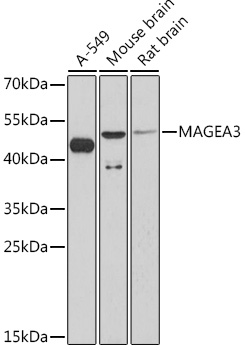Cell Biology Antibodies 14
Anti-MAGEA3 Antibody (CAB16915)
- SKU:
- CAB16915
- Product Type:
- Antibody
- Reactivity:
- Human
- Reactivity:
- Mouse
- Reactivity:
- Rat
- Host Species:
- Rabbit
- Isotype:
- IgG
- Antibody Type:
- Polyclonal Antibody
- Research Area:
- Cell Biology
Description
| Antibody Name: | Anti-MAGEA3 Antibody |
| Antibody SKU: | CAB16915 |
| Antibody Size: | 20uL, 50uL, 100uL |
| Application: | WB |
| Reactivity: | Human, Mouse, Rat |
| Host Species: | Rabbit |
| Immunogen: | A synthetic peptide of human MAGEA3. |
| Application: | WB |
| Recommended Dilution: | WB 1:500 - 1:2000 |
| Reactivity: | Human, Mouse, Rat |
| Positive Samples: | A-549, Mouse brain, Rat brain |
| Immunogen: | A synthetic peptide of human MAGEA3. |
| Purification Method: | Affinity purification |
| Storage Buffer: | Store at -20°C. Avoid freeze / thaw cycles. Buffer: PBS with 0.02% sodium azide, 50% glycerol, pH7.3. |
| Isotype: | IgG |
| Sequence: | Email for sequence |
| Gene ID: | 4102 |
| Uniprot: | P43357 |
| Cellular Location: | |
| Calculated MW: | |
| Observed MW: | 42kDa |
| Synonyms: | MAGEA3, CT1.3, HIP8, HYPD, MAGE3, MAGEA6 |
| Background: | This gene is a member of the MAGEA gene family. The members of this family encode proteins with 50 to 80% sequence identity to each other. The promoters and first exons of the MAGEA genes show considerable variability, suggesting that the existence of this gene family enables the same function to be expressed under different transcriptional controls. The MAGEA genes are clustered at chromosomal location Xq28. They have been implicated in some hereditary disorders, such as dyskeratosis congenita. |
| UniProt Protein Function: | MAGEA3: Proposed to enhance ubiquitin ligase activity of RING- type zinc finger-containing E3 ubiquitin-protein ligases. May enhance ubiquitin ligase activity of TRIM28 and stimulate p53/TP53 ubiquitination by TRIM28. Proposed to act through recruitment and/or stabilization of the Ubl-conjugating enzyme (E2) at the E3:substrate complex. May play a role in embryonal development and tumor transformation or aspects of tumor progression. In vitro promotes cell viability in melanoma cell lines. Antigen recognized on a melanoma by autologous cytolytic T-lymphocytes. |
| UniProt Protein Details: | Protein type:Cancer Testis Antigen (CTA) Chromosomal Location of Human Ortholog: Xq28 Cellular Component: endoplasmic reticulum Molecular Function:protein binding Biological Process: negative regulation of caspase activity |
| NCBI Summary: | This gene is a member of the MAGEA gene family. The members of this family encode proteins with 50 to 80% sequence identity to each other. The promoters and first exons of the MAGEA genes show considerable variability, suggesting that the existence of this gene family enables the same function to be expressed under different transcriptional controls. The MAGEA genes are clustered at chromosomal location Xq28. They have been implicated in some hereditary disorders, such as dyskeratosis congenita. [provided by RefSeq, Jul 2008] |
| UniProt Code: | P43357 |
| NCBI GenInfo Identifier: | 1170857 |
| NCBI Gene ID: | 4102 |
| NCBI Accession: | P43357.1 |
| UniProt Secondary Accession: | P43357,Q6FHI6, |
| UniProt Related Accession: | P43357 |
| Molecular Weight: | 34,747 Da |
| NCBI Full Name: | Melanoma-associated antigen 3 |
| NCBI Synonym Full Names: | MAGE family member A3 |
| NCBI Official Symbol: | MAGEA3 |
| NCBI Official Synonym Symbols: | HIP8; HYPD; CT1.3; MAGE3; MAGEA6 |
| NCBI Protein Information: | melanoma-associated antigen 3 |
| UniProt Protein Name: | Melanoma-associated antigen 3 |
| UniProt Synonym Protein Names: | Antigen MZ2-D; Cancer/testis antigen 1.3; CT1.3; MAGE-3 antigen |
| Protein Family: | Melanoma-associated antigen |
| UniProt Gene Name: | MAGEA3 |
| UniProt Entry Name: | MAGA3_HUMAN |







